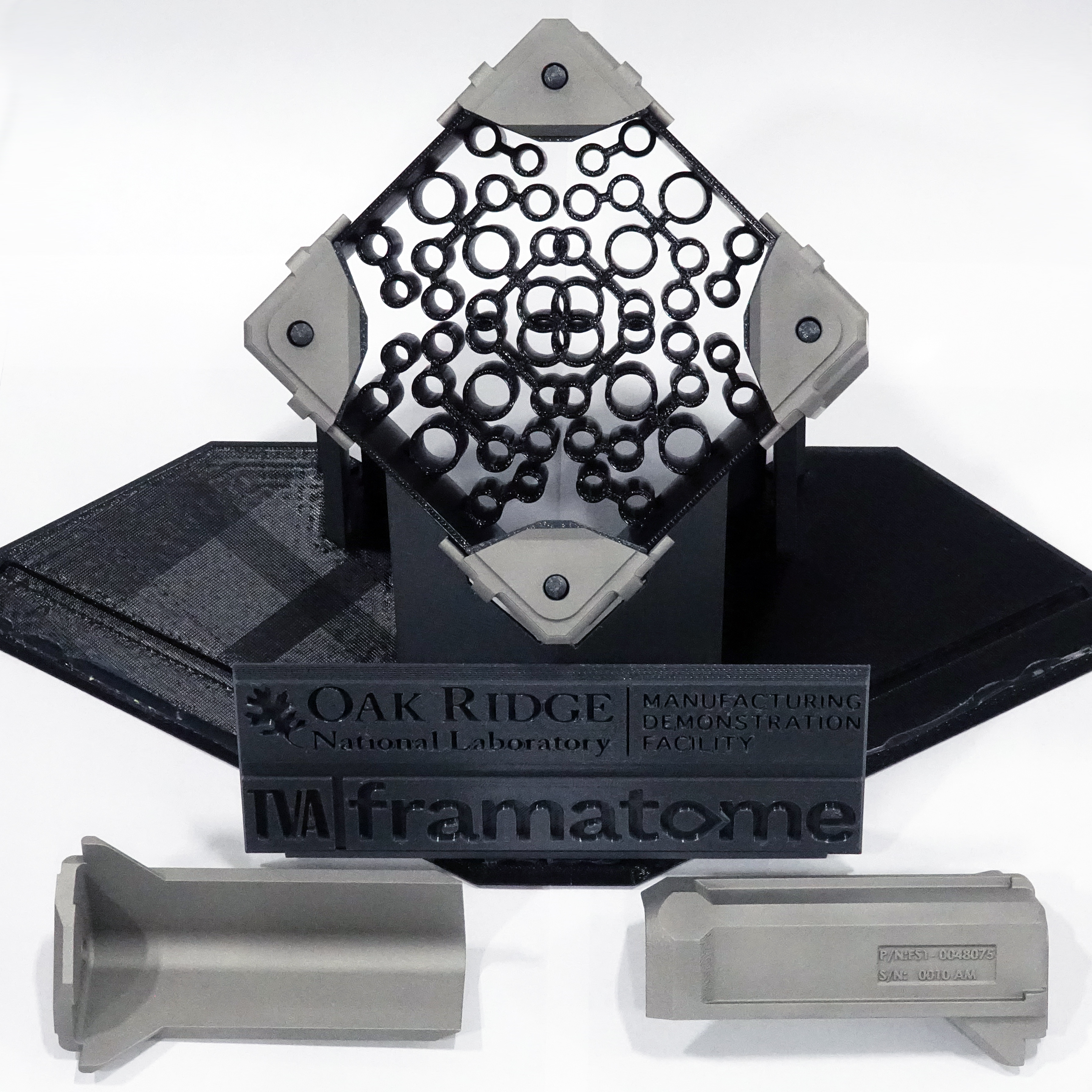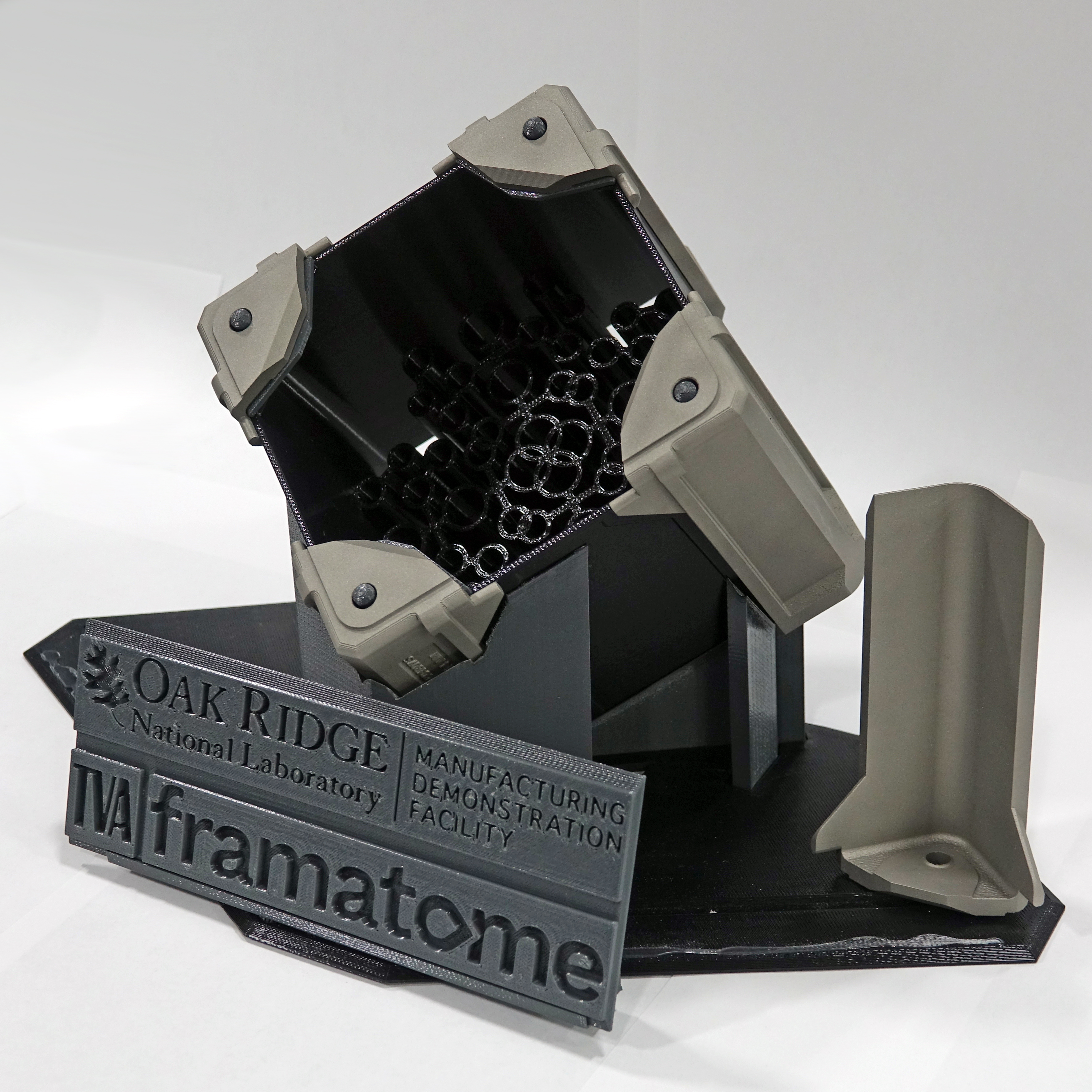The Transformational Challenge Reactor, or TCR, a microreactor built using 3D printing and other new advanced technologies, could be operational by 2024.
But the technology being used to develop the 14th reactor at the Department of Energy's Oak Ridge National Laboratory may be tested in currently operating nuclear reactors as early as this spring.
Recently, ORNL partnered with Tennessee Valley Authority and Framatome Inc., a TVA nuclear fuel supplier based in Richland, Washington, to introduce parts produced using additive manufacturing, or 3D printing, techniques into existing nuclear reactors. These are the same techniques being developed and tested as part of the ORNL-led TCR demonstration program to enable faster and cheaper nuclear energy deployment for the United States.
The parts are channel fasteners for the fuel assembly, which are set to be installed in TVA's Brown's Ferry nuclear power plant in spring 2021. This will represent two first-of-a-kind demonstrations: the first-ever additively manufactured safety-related parts to go into a nuclear reactor, and the first physical parts that have "digital twins," or exact virtual models, created using TCR's advanced monitoring and artificial intelligence techniques while being manufactured.
"We were asking ourselves, how do we add value along the way to the entirety of the nuclear community with this program?" said ORNL's Kurt Terrani, TCR director. "The whole purpose of TCR is to show that you can bring new technologies and apply them to achieve more affordable nuclear power in a faster manner."
Certifying additively manufactured parts
ORNL has been pursuing partnerships across a wide swath of industry, ensuring the groundbreaking technology developed through the TCR demonstration program is available for other related applications. The TVA-Framatome venture is just one example, Terrani said.
In this case, ORNL is using additive manufacturing to produce specialized components for the fuel assembly of a boiling water reactor at the Browns Ferry Nuclear Plant in Alabama. Framatome supplies the fuel for that TVA reactor.
The additively manufactured components are channel fasteners, a type of bracket attached to the top of the assembly to hold the channel that wraps around the assembly and guides coolant flow up through the bundle. It was chosen in part because it has a straightforward, though non-symmetric, geometry and is a relatively simple part - ideal for a first-of-a-kind demonstration of additive manufacturing, in which material is deposited in layers, following a computer-designed model, to form precise shapes without the need for later carving or machining.
"It wasn't a challenging component," said Fred List of ORNL's Physical Science Directorate. "What we were trying to figure out is some of the simple things additive manufacturing needs to overcome to make that model very precisely - layer by layer - with minimal distortion."
John Strumpell, manager for U.S. Fuel R&D at Framatome's Lynchburg, Virginia, location, called the channel fastener "a low-stress part."
"It's ideal for this demonstration because it's low risk," Strumpell said.
Using additive manufacturing's micro-welding process, the shape of the channel fastener can be changed in miniscule increments, List said. And although it's possible additive manufacturing will turn out to be a more cost-effective way to manufacture the part, which is typically cast and machined, this is also serving as a test case for TCR's digital platform that is targeting a method to quickly certify the quality of components that will go into nuclear reactors, said ORNL's Ryan Dehoff, section head for Secure and Digital Marketing.
"For the first time, we are putting a part into a Nuclear Regulatory Commission-licensed reactor that has all the digital manufacturing data behind it," Terrani said. "This is one of the first steps in our coordinated efforts with the regulator and the nuclear vendors to prove that a new and greatly accelerated approach for part qualification is possible."
Developing and demonstrating this approach, in which additive manufacturing and artificial intelligence are combined to monitor the production process and certify part quality, is a key objective of the TCR program.
"Deployment of additive manufacturing technology for these channel fasteners is low risk and opens the door to manufacturing more complicated parts going forward," said Travis Turner, Site Nuclear Fuel Projects program manager for Tennessee Valley Authority.
Adding value to nuclear overall
Dehoff said leveraging TCR, which is supported by DOE's Office of Nuclear Energy, to address these industry challenges only makes sense.
"This was a valuable opportunity," he said. "It's important to know who your neighbors are. They have, in their reactors, a lot of the same concerns and issues that we are solving with TCR."
"We were excited to have an opportunity to take advantage of new technological advances generated by the TCR program, which potentially could lower costs in future reactors," said Dan Stout, TVA's director of Nuclear Technology Innovation. "TVA is positioned well to help facilitate testing of these pre-qualified additively manufactured components, hopefully paving the way to obtaining regulatory approval."
Strumpell said Framatome and other companies especially appreciate government collaboration because it lets them explore emerging technologies without having to invest in first-generation equipment that could quickly become obsolete. With ORNL helping to manage the risk, he said, companies like Framatome can deploy far-reaching technologies, an approach that benefits the industry as a whole.
In addition, he said, private companies generally don't have the lab's level of research and development resources and expertise.
"Being able to reach out to an organization with vision and capabilities, and being able to partner with them whenever we have a need, gives us flexibility in the way we design our products," Strumpell said.
While the TCR program's ultimate goal is to produce an additively manufactured microreactor and have it up and running by 2024, Terrani said it's already advancing innovation in a tangible, useful way.
"We're adding value in all different sectors of the domestic nuclear industry," he said.








